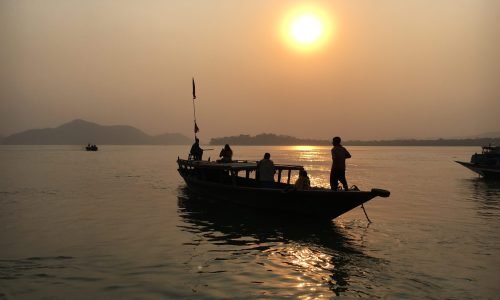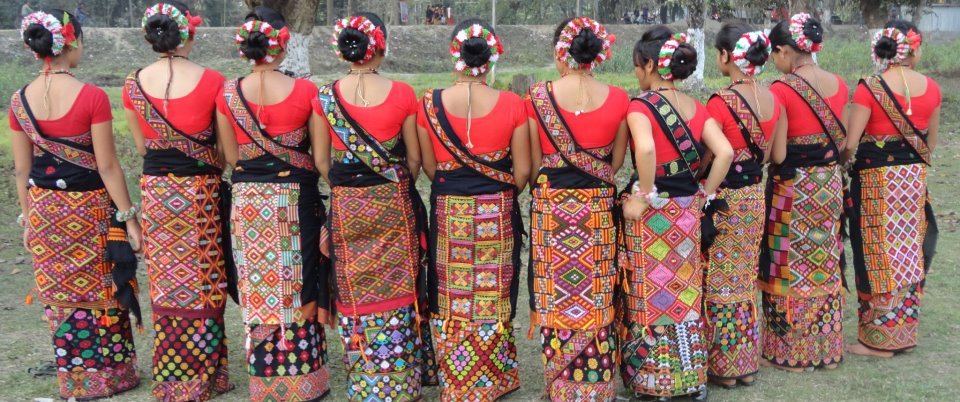

“Brahmaputra Mahabahu Santanu Kulonandan
Amogha Garbhasambhritta Papang Lohitya me Hara”
(The mighty Brahmaputra keeps flowing in a quiet and peaceful manner, washing away sins within its wide arms).
The name “Mising” originates from the words mi (man) and asi (water), and it is commonly used to refer to, “man of the water.” A major ethnic group in northeast India, Mising Tribe also referred to as Miri, originally a hill tribe, inhabited the Miri Hills range between Siang and Subansiri districts of Arunachal Pradesh and migrated around the 13th or 14th century to the Brahmaputra valley from the eastern Himalayan mountains. Prior to the advent of Ahoms, they settled in the riverside areas of Brahmaputra and Subansiri. Assam is a melting pot of diverse multiethnicity and the traces of the beardless cheek, and broad shoulders speak about the Mising tribe’s Tibeto-Burman ethnicity.

Currently, they occupy the plains of Assam and some parts of Arunachal Pradesh, in the northeast India. They are fragmented across upper and middle regions of Brahmaputra, in mostly flood-prone zones of Assam, which include, Dhemaji, Tinsukia, Dibrugarh, Lakhimpur, Sivsagar, Jorhat, Golaghat, Sonitpur as well in the world’s largest river island, Majuli. Over the centuries, Mising have developed a treasure trove of traditional ecological knowledge to battle with the unpredictable fury of the mighty Brahmaputra. The self-sufficient life of the community is reflected by the Mising villages. The community resides near a river or a pond that provides fish, a forest or ‘chapori’, which serves as a source for fruits, wood, firewood, herbs, etc, and grazing land for the livestock/cattle to feed on. The preparedness on the part of Mising before the advent of floods is illustrated in the practices of Mising around paddy cultivation, farming, fishing and storing of grains and also in their architecture and the focus on “Lai aam”, i.e rice cultivation in the dry season. They also engage in ‘Aamdang Arig’, wet paddy cultivation. The multi crop cultivation in turn leads to stability of food grain production and quality of soil.
The traditional wooden house of Mising, ‘Chang kar’, in Assamese and traditionally known as Taleng Okum, itself reflects the adaptability of the community to the erratic nature of the Brahmaputra. These houses have mud foundations and are built on bamboo slits with a bamboo thatch roof, bamboo is extensively used for constructing these houses, as is evident in flooring as well. The river shapes the lives of Mising, due to which these houses are raised every year 5 ft to 10 ft to adjust to the flood each year.

Originally Mising language had no script though Roman script in a modified way is used as their written language. The oral tradition of folklore, myth, songs, and chants has preserved a vast corpus of knowledge for the community despite the lack of script. A Mising legend reveals how their script and language were lost. The God of knowledge, Do-ying Ba-bu, is said to have given the Misings their script and instructed them to carefully preserve it by writing it down on the tree bark. But the Misings recorded it on a piece of deer skin that was preserved for many years. After a long period of time, the community was struck by a severe famine, and the river dried up, forcing the Misings to consume all of their poultry. The deer skin’s custodian was so hungry and in need of meat that he roasted it and consumed it, which caused the Misings to permanently lose their script.
The community’s religious practices are animistic and revolve around the creation of the universe, spirits around human habitats and the human soul. The Mising community believes the creator of the universe is Sedi Babu (father Sedi) and Melo (Mother). Abo – Tani, the creators of the human race, were born from Sedi-Melo. Donyi (the Sun), Polo (the Moon), and Abo (Tani) were all born from Abo-Tani. Mising identify themselves as a descent of Donyi (the Sun) and Polo (the Moon). The traditional chief festivals of the community are connected to agriculture. The chief festivals are – Ali – Aye- Ligang and Porag. Ali aye Ligang is the most important festival, marking the start of agrarian activities, starting of a new season with the sowing of seeds.

Though over the years, the community has lost the original traditional fishing, individual and community fishing is still done with effervescence. Varied factors such as the physiography of the water body, the nature of fish stock influence fishing methods and gears. There are around 32 gears that are prevalent in the Mising community. The most common are Kawai Langi (gill nets), Tongi Jal (lift nets), Jakai, Borchalani, Juluki (bamboo traps) and Danari Barashi (fishing line). The community has adopted two different methods of fish preservation: “Perup hukati”, (small fish that has been dried and smoked) and “Numsing hukati”, (fish that has been dried and smoked into a powder). The community keeps a wooden boat known as “Ollung,” which exhibits sustainable practices which they use for fishing or to escape from floods. They also produce banana-trunk rafts.
In conclusion, the deep-rooted connection of the Mising tribe with the Brahmaputra River is visible in the diverse cultural mosaic of the community. The sustainable practices adopted by the community and the intricate knowledge of the Brahmaputra River and its tributaries are reflected in the cultural fabric of the community intricately woven with rituals wherein reverence for nature and the river is evident. Their harmonious interaction with the water bodies teaches us to preserve the ecological heritage to navigate the challenges of the fast pacing modern world. The rhythms of the Brahmaputra deeply shape the life of the community wherein sustainable practices adopted by them bestow life and nourishment upon the region.